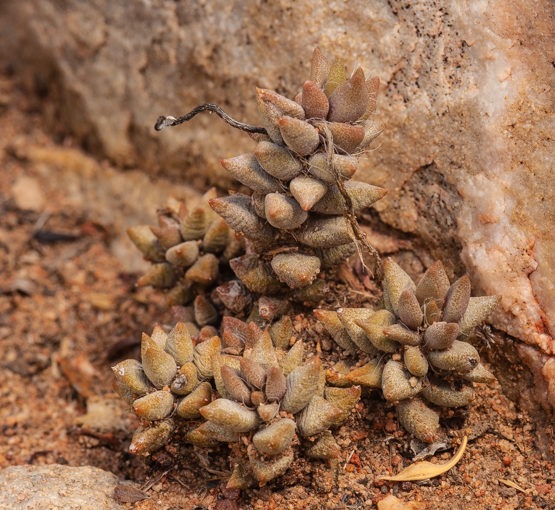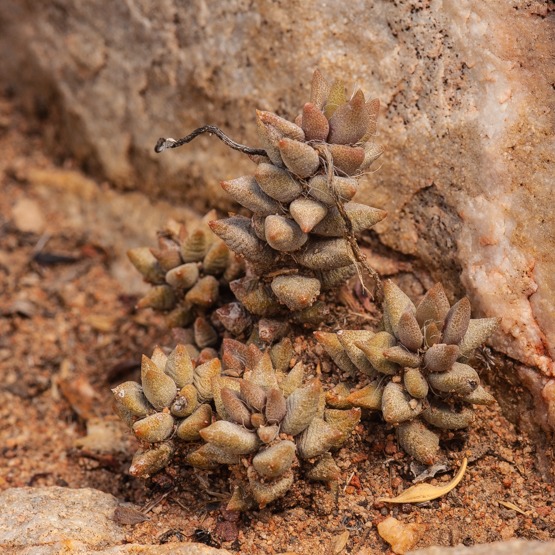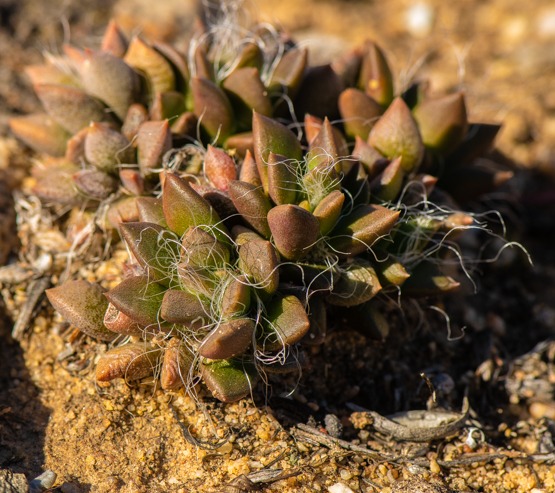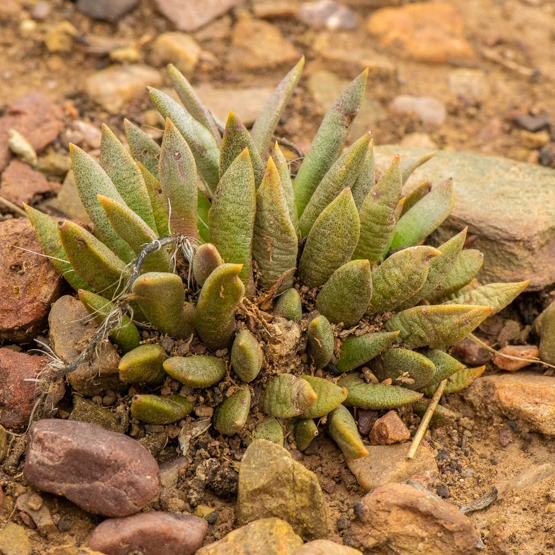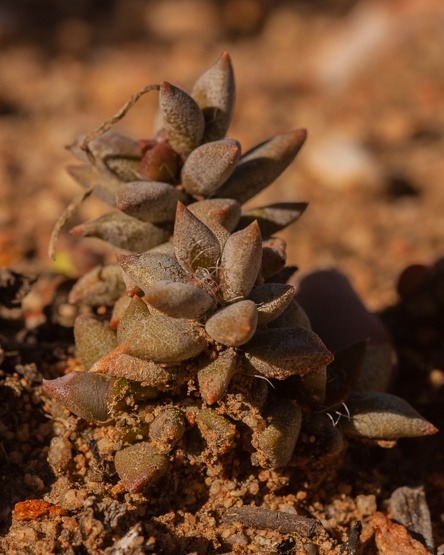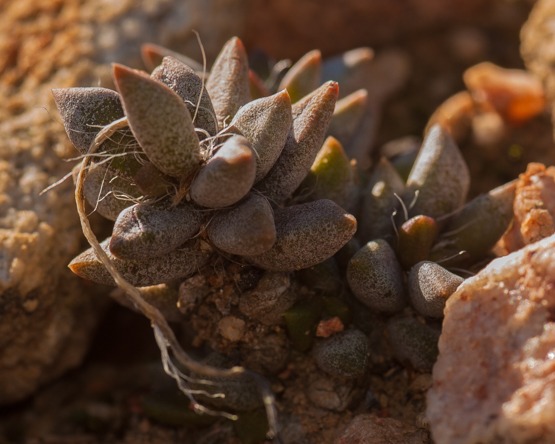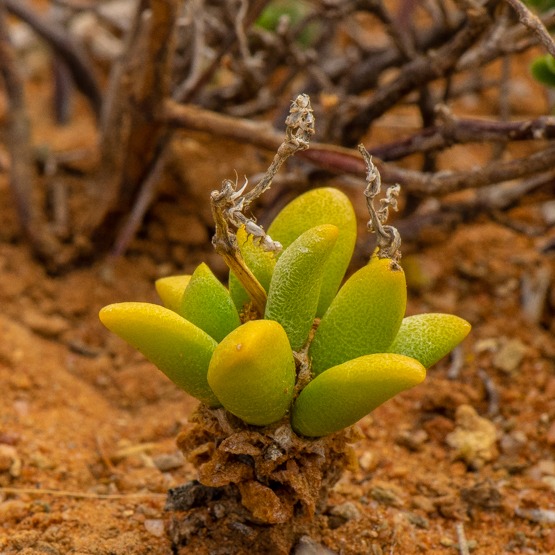Guest column by Theo Heijnsdijk
In 1897, professor Peter MacOwan, a British botanist working in South Africa, sent a specimen of Euphorbia meloformis, known since 1774 , to the Royal Gardens in Kew near London. At least that’s what he thought. When the plant came into bloom in the succulents greenhouse in 1899, it clearly turned out to be a different species. According to historiography, this unique plant then disappeared from the Kew collection (probably a concealing way of saying that the plant died). Happily, they had made coloured drawings of the flowering plant (fig.1). That gave enough information to Sir Joseph Dalton Hooker, Kew’s resident botanist, to go ahead with a description in 1903.

Euphorbia obesa is a dioecious species, in other words, a plant which develops only female or only male flowers. The drawing clearly shows a female plant, but in a detailed drawing ‘stamens’ are shown (no. 4 on the plate) and in the description it says: “Filaments anantherous, hirsute”, which means that the stamens are bristly hairy (hirsute) and do no bear anther buds (anantherous). It probably concerns rudimentary stamens that do not develop in a female cyathium. Or would Hooker have mistaken the incised slips of the cup-shaped shell (involucrum) for stamens?
E. obesa remained very rare for some time. In 1907, Alwin Berger in his ‘Sukkulente Euphorbien,’ reported that the Kew plant up to then was the only known specimen. And in the part on the Euphorbiaceae in the ‘Flora Capensis’, N.E. Brown in 1915 reported that only female plants were known. In the Netherlands, the species was first admired in 1924 at the first Succulent Plant Exhibition in The Hague. The owner had bought the plant at the World Exhibition held at Wembley in the same year. In 1926 we find the first photo in the Dutch magazine ‘Succulenta’. Because of its rarity, E. obesa was a coveted plant at the time and people were willing to pay large sums of money for it. As a result, the localities were literally looted once they were known. The South African government recognized that there was a threat of extinction and to prevent that, an export ban for live plants was imposed in 1931.
The species name obesa means ‘thick’, ‘fat’, ‘swollen’. Just think of the new health issue obesity, in which the same word is incorporated. In this context, it is worth mentioning that the plant in South Africa is called vetmensie (‘little fat human’).
Another South African name is ‘klipnoors’. Klip means stone or boulder and noors is the name which in the Jansenville area was given to the common yellow-flowered and rather thorny Euphorbias. These reminded the British of the gorse (Ulex europaeus) found in England. This then was probably corrupted by the Dutch to Noors (‘Norwegian’). The region around Jansenville is now called Noorsveld and ‘Noors’ has become a designation for Euphorbias in general. A klipnoors is therefore a Euphorbia that looks like a piece of stone.
Names in English are: Living baseball, Eisenhower’s golf ball, Baseball plant, Sea urchin (zee-egel). This last one obviously as a reference to a sea urchin’s shell. See Fig. 2 and 3 below.

Fig. 2 Euphorbia obesa subsp. obesa, in South Africa called vetmensie (a fat person).

The species occurs near the town of Kendrew in the Graaff-Reinet district (on the west side of the Eastern Cape). There the plants grow on the top and the southern slopes of low hills, between 300 and 900 meters above sea level and also on the flat parts between the hills. On these flat parts they occur in sandy soil under shrubs, but on the slopes the soil is much more stoney. The colours of the plant body match the environment so well that it is difficult to find one.
In summer, the maximum temperature is on average 26 °C and the minimum temperature 11 °C. In winter it sometimes freezes slightly. The annual rainfall is 200 to 300 mm, spread over two periods. In late spring (October – November) there is some precipitation and at the end of the summer (March – April) larger quantities are registered. Most of the rain falls during thunderstorms. Apparently, the plants are eaten by the numerous baboons and by the cattle of the farmers. The milky juice does not seem to bother these animals.
Fortunately, despite the collecting frenzy of the enthusiasts, there are still some populations left (perhaps overlooked at the time). They are now protected, sometimes even by placing a fence around them.
It is also completely unnecessary nowadays to remove these plants from nature. They are grown in large numbers and the cultivation is certainly not difficult. It is actually incomprehensible that in 1935 it was still thought that the species could hardly be kept alive, as appears from the following fragment from the question and answer section in the October issue of ‘Succulenta’:
“For Euphorbia obesa, the ‘right’ culivation in our country has not yet been discovered. At best, one can keep this most remarkable of all Euphorbias, which only occurs in one part of the Cape Colony (Kendrew in the district of Graaff Reinet northwest of Port Elisabeth), alive for a few years. They slowly wither away in our country: there is usually no question of them getting any bigger.”
For a long time, it was believed that the species indeed only occurs in the immediate vicinity of Kendrew, south of the town of Graaff Reinet, but apparently there are also populations north and northeast of Graaff Reinet.
Sensational was the discovery by Robert Allen Dyer in 1939 of a population of a similar plant on Mr. Stegman’s Kruidfontein farm, 19 miles west of Willowmore, on the road to Rietbron. This is at a distance of more than 100 km southwest of Kendrew and in the intermediate area no plant resembling an E. obesa has ever been found. This plant was described in 1941 by White, Dyer and Sloane as a separate species, E. symmetrica (fig. 4).

The main difference with E. obesa, in addition to the geographical separation of course, is that the points from which the inflorescences originate (called flowering eyes), are different in shape. In E. obesa they are round dots from which one flowering stem (peduncle) originates, but in E. symmetrica it is an elongated transverse stripe, and this offers space for several (up to 5) flowering stems next to each other (fig. 5). Incidentally, in E. obesa there may also be several inflorescences together, but in that case, they originate from one branched flowering stem.

In addition, E. symmetrica keeps its spherical shape much longer than E. obesa. In the long run, however, it also becomes taller than wide.
Also, in E. symmetrica the taproot is supposed to develop much more vigorously. Later on it was also mentioned that young seedlings are spherical in E. symmetrica and cylindrical in E. obesa. Gordon Rowley in 1998 found the differences too small to distinguish 2 separate species and he reduced E. symmetrica to a subspecies, E. obesa subsp. symmetrica. The original E. obesa is now called E. obesa subsp. obesa.
In an article by Gerhard Marx in the magazine Cactus & Co, some more differences are mentioned: in subsp. symmetrica the head is more sunken than in subsp. obesa; the colored stripe pattern on the plant body in subsp. symmetrica (especially visible in seedlings) consists of fewer, but wider and more pronounced bands than in subsp. obesa and under identical conditions, especially with regard to the amount of light, the colour of subsp. obesa is more purple blue-grey and of subsp. symmetrica green to yellow-brown. Young seedlings are clearly greener in subsp. symmetrica.
Propagation by seed works very well in E. obesa and the seedlings quickly develop into beautiful little balls. On April 29, 2008, I sowed 25 seeds of subsp. symmetrica (from my own plants) in 5 neat rows of 5 in a pot of 8 x 8 cm (at the top). I always sow at a temperature of 25 °C to 30 °C. Within one week, 13 seelings had already emerged. In fig. 6 we see the pot with seedlings on May 18, so barely 3 weeks after sowing. By then the 22nd seedling had just emerged from the soil.

In fig. 7 we see the same pot on July 13, almost 11 weeks after sowing. Now there are 23 seedlings on display. A success rate of 92%. If the seedlings are not transplanted, sometimes a seed will germinate in the next year. A late vocation, shall we say.

As far as the soil is concerned, the plant is not very demanding, but a mineral composition is recommended. Water regularly in the growing period and keep dry in winter. According to the literature, temperatures down to -10 °C. are tolerated when the soil is completely dry.
Subsp. symmetrica is perhaps a little more sensitive to cold. In its habitat it does not get as cold as at the localities of subsp. obesa.
Over the years, a whole series of abnormalities has been reported among the countless cultivated specimens of subsp. obesa. Of course, cristates have been known for a long time. Usually they are grafted but this is not really necessary. One of my seedlings from 1998 changed into the cristate form from the beginning. Fig. 8 shows part of this now 14-year-old plant which still has its own root system.

E. obesa does not normally form side shoots, but in some specimens, shoots are produced from the base. The designation ‘forma caespitosa‘ was coined for this. Bizarre in appearance is ‘forma prolifera‘, in which a new shoot is created from every growing-point. It is very similar to the witch broom disease that occurs in some cacti.
On to deviations in flowering. Under the not so correct title “Impotence in Euphorbia obesa“, J. Mieras reports in 1978 a male plant whose stamens do not develop and in 1979 a female specimen is reported in which the pistil does not develop normally.
Male plants which become females and vice versa also occur. In addition, in 1983 P.H. den Hartog reported a plant of which all cyathia are bisexual. So, both pistil and stamens in one cyathium. In my own collection I have observed in both subspecies that there are male specimens which regularly produce bisexual cyathia and fruits thereof (fig. 9).

Furthermore, there is the obesa with deformed stamens mentioned by Riet Maessen in the December issue of Succulenta 2012 (fig. 10).

Then there are the plants that proceed to multiple dichotomous division without this leading to the formation of a crest (cristate). These forms are referred to as ‘forma polytomica‘. Mixed forms of polytomic and cristate growth also occur. Gordon Rowley gives these types of shapes the name “Rocky Mountain”. Unfortunately, the species was not designed to undergo such a drastic change in shape and that means that cracks will occur, resulting in ugly brown spots.
I have a few such forms in my possession, all female ones and there is a lot to experience there. To start with, the pistils are not only 3-fold but also 4-, 5- or 6-fold and after pollination with a normal obesa, this results in fruits with 3 to 6 compartments (fig. 11 and 12).


Fig. 12 Close-up of the fruits in Fig. 11.
On one of those plants, a kind of monstrose way of flowering began to develop 2 years ago in which a still expanding lump of cyathia has arisen (fig. 13).


Fig. 14 On the right a seedling of E. obesa subsp. obesa with 3 seed-leaves.
This is a phenomenon that also occurs quite frequently in cacti. Other seedlings will keep making new ribs so that after 1 year there are already about 13 instead of the usual 8. In the second or third year, such a seedling then proceeds to dichotomous division. In fig. 15 we see such a plant after the division is complete and fig. 16 shows such a plant at a more advanced stage.

Fig. 15 After forming about 20 ribs, this seedling of E. obesa subsp. obesa decided that it was necessary to divide dichotomously.

Fig. 16 A plant of E. obesa subsp. obesa divided dichotomously.
So all this refers to offspring of a monstrose female plant that has been pollinated with pollen from a normal male plant. In any case, the phenomenon seems to have a hereditary component. I wonder how big the percentage of abnormal offspring is if the supplier of the pollen is also a monstrous form.
What remains to be told is the fact that E. obesa hybridises rather easily with other species and that the plants in our collections will not all be true to type. As long ago as 1938, ’Succulenta’ contained a picture of E. obesa x submammillaris. In addition, there is a cultivar on the market under the name of “William Denton” which is claimed to be a hybrid with E. mammillaris. Common are hybrids with E. meloformis. Among other things, these are distinguished from the true obesa by the fact that the flowering stems, just like in E. meloformis, usually are not shed after flowering. Hybrids with E. horrida, E. globosa and E. ferox are also known.
LITERATURE
Berger, A. (1907). Sukkulente Euphorbien. Ulmer Verlag, Stuttgart: 102.
Brown, N.E., Hutchinson, J, Prain, D. (1915). Euphorbiaceae in Thiselton-Dyer, Flora Capensis, William Clowes and Sons, London, Vol. 5, sect. 2, part 2, p. 359.
Hartog, P. H. (1983). De sexuele spelingen van Euphorbia obesa. Succulenta 62 (11): 258.
Hooker, J. (1903). Curtis’ Botanical Magazine 129, tab. 7888.
Houten, van den, J.M. (1926). Merkwaardige Euphorbias, Succulenta 8 (7/8): 100.
Killick, D. J. B. (1978). The flowering plants of Africa.
Laren, van, A, J. (1932). Vetplanten, Verkade’s fabrieken N.V., Zaandam.
Marx, G. (2012). The South African spherical spurges, Cactus & Co 16 (2): 70 – 81.
Mieras, J. (1978). Impotentie bij Euphorbia obesa, Succulenta 57 (7): 150.
Mieras, J. (1979). Nogmaals Euphorbia obesa, Succulenta 58 (8): 203.
Rowley, G. (2006). Teratopia, Cactus & Co.
Sluys, van der, C. (1938). Euphorbia obesa x Euphorbia submammillaris, Succulenta 20 (1): 11.
Thoorn, J.J.E. van de, (1935). Vragenrubriek, Succulenta 17 (10): 159.
White, A., Dyer, R., Sloane, B. (1941). The Succulent Euphorbieae 2: 559, Appendix A: 964.
First published in Succulenta 92 (6), December 2013. Translation from the Dutch by F.N.
